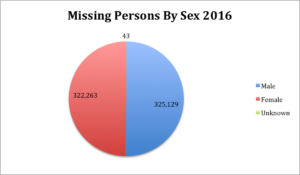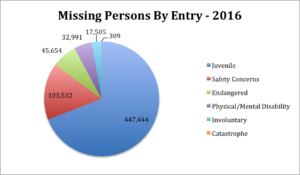
Vanished: An American Tragedy
The heartbreaking stories of multiple victim events, including human trafficking and homicide, and their implications for investigators and first responders, among others, will be the focus of the 2017 Annual National Missing and Unidentified Person’s Conference (MUPC) in Atlanta in September. We give you a broad overview on America’s hidden victims, some of the issues faced in investigating these complex cases, and a look at what this year’s conference will be about.
By the National Criminal Justice Training Center (NCJTC)
 Missing persons investigations are complex and multilayered. While the attention of the media is often focused on victims that are kidnapped by a stranger, these cases actually constitute only a small fraction of those that are reported; most involve individuals that wander off, are lured away by known perpetrators, run away, or are homeless because of a number of other stressors.
Missing persons investigations are complex and multilayered. While the attention of the media is often focused on victims that are kidnapped by a stranger, these cases actually constitute only a small fraction of those that are reported; most involve individuals that wander off, are lured away by known perpetrators, run away, or are homeless because of a number of other stressors.
As law enforcement, service providers and communities struggle to identify these individuals as “missing,” their cases often do not receive adequate resources. These missing individuals are our nation’s hidden victims.

The 2016 Missing Person and Unidentified Person Statistics report from the National Crime Information Center (NCIC), the country’s primary database for tracking crime, indicates that there were more than 645,000 missing person records entered into their database last year, of which 88,040 were still considered active missing persons cases at year’s end. Of these, 33,706 were of children under the age of 18, and 42,807 of persons below the age of 21. There were also 8,431 active unidentified persons records in the system on Dec. 31, 2016. Of these, 894 cases were entered in 2016. The NCIC was established in 1967 and their Missing Persons File was established in 1975.

The numbers above include adults and minors, males and females, people of various ethnicities, as well as individuals of all ages. They also include people with a proven physical or mental disability that were reported missing, under circumstances that suggest that they were in danger, those that went missing after a catastrophic event, and persons that were absent under circumstances that might not have been voluntary. All of this serves to remind us of a tragic truth — abduction, victimization, and exploitation are not discriminatory crimes, they could happen to anyone, anywhere, anytime.
Despite the haste and the tireless efforts of various stakeholders, many missing person cases remain unresolved. It’s important to note that even though the NCIC database classifies more than 88,000 as “active” as of December 2016, this, unfortunately, doesn’t mean that all the rest of the cases in their system were resolved.
Cases are “purged” from the database (contributing to their removal from active status), for any number of reasons: A case could be canceled/cleared, a person could be located by another agency, or a record could be removed by the agency that made the original entry because they determined that the record was invalid. The cases purged in any given year could have had an initial entry date of many years ago. Thus, the numbers do not add up, and it’s very difficult, if not impossible, to get a definite number on actual active cases across the country.
The Big Bad Data Problem
One of the major issues, as it relates to missing persons, is the lack of consistency and information-sharing across data sets. As a result, according to the U.S. Government Accountability Office’s 2016 report on Missing Persons and Unidentified Remains: Opportunities May Exist to Share Information More Efficiently, persons who rely on just one source may miss information that could be instrumental in solving missing persons’ cases. For instance, there are differences in the data available on the FBI-run NCIC database, and NamUS, which is the National Missing and Unidentified Persons System (NamUs). NamUS, a national centralized repository and resource center for missing persons and unidentified decedent records, is supported by the National Institute of Justice — the research, development and evaluation agency of the U.S. Department of Justice. While both databases are operated by Department of Justice agencies, the accessibility and user-ability of the databases varies; therefore creating discrepancies in the way data is entered and validated.
Additionally, there are classification issues. NamUS classifies an unidentified person as a deceased person whose body is as yet unidentified, while the FBI’s 2016 Missing Person and Unidentified Person report defines “unidentified persons” under two categories, EUL (living unable to be identified), and EUV (unidentified catastrophe victims).
Over and above all this, states may code their missing persons entries differently, incomplete entries are often added, and there is a lack of hard data/research related to the issue.
These cases are often wrought with other challenges too — a lack of resources, legal hurdles, and complex technology or coordination issues. Cases that result in closure, identification, and recovery are often due to the rapid coordinated response of law enforcement, emergency management, search and rescue professionals, and their partners. And, while there is no one best approach or solution to resolving these cases, professionals agree that collaboration and the leveraging of all possible resources — including those from the community, geospatial and surveillance technology, telecommunications and social media — are crucial to the effectiveness of search and recovery of all missing persons, irrespective of the circumstances involved.
Atlanta: What We Could Do
It is with all of this in mind that experts from various fields and disciplines across the country are converging in Atlanta to discuss the application of new techniques, technologies and resources to resolve missing persons cases, at the annual National Missing and Unidentified Person’s Conference (MUPC). This year’s event, entitled “Multiple Victim Events: Implications for Investigation, Search, Rescue, and Recovery,” will feature presentations on effective strategies for responding to mass incidents and missing persons’ reports, including those involving human trafficking and serial homicide.
The conference is the first of its kind to provide law enforcement with a forum to discuss the complex nature of missing persons’ cases, and to develop strategies to improve the responses to victims and families.
Among the many experts participating in the discussion are Jason Moran from the Cook County Sheriff’s Police Department, who applied various forensic and DNA techniques to identify victims of the serial killer, John Wayne Gacy, decades after the serial killer sexually assaulted, tortured, and murdered more than 30 young men and boys between 1972 and 1978; Biometrica CEO Wyly Wade, who will explore how facial recognition technology can aid in the identification and recovery of missing persons and in tracking crime: John Beck from Esri, who will discuss the application of geospatial intelligence in missing persons’ cases; and Chris Young from the Bay Area Search and Rescue Council (BASARC), who will speak about critical collaborations in the search for missing persons, to name just a few.
There’s more. Bill Kearney, Co-founder of WB Kearney & Associates, shares more on what we will learn from a panel of experts that will explore the art of possibilities in the missing and unidentified persons realm.
Also hear from Amanda Pick, the CEO of the Missing Children Society of Canada, on how to leverage technology to increase information sharing and collaboration among law enforcement, key stakeholders, and the community.

This piece is courtesy the National Criminal Justice Training Center (NCJTC) of Fox Valley Technical College, which recognizes that the factors that put adults and children most at risk for harm are often complex and misunderstood. For more than 20 years, NCJTC has provided national training and technical assistance to agencies, organizations, and individuals in the criminal justice field on a multitude public safety issues. Through its National Conference on Responding to Missing & Unidentified Persons, NCJTC offers innovative approaches, techniques, and technologies to more effectively investigate the tragic circumstances surrounding missing person’s reports.